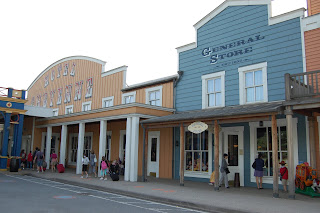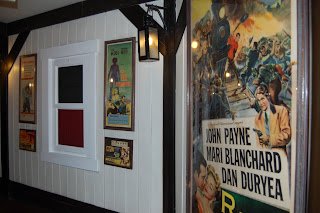Finishing our tour of the hotels of Disneyland Paris, let's stroll down the Rio Grande (the name given the canal which runs from Lake Disney) toward the French equivalent of the moderate resorts, Hotel Cheyenne and Hotel Santa Fe.
The second property designed by architect Robert Stern, Hotel Cheyenne offers Guests the opportunity to stay in a western frontier town, albeit one more inspired by films like High Noon than based in reality.
A stagecoach has pulled up out front to deliver folks and freight, and look who stopped by, in full Native American garb no less. Apart from being a fantastic outfit for Mickey and a great location for photos, this spot also provided me one of the most unforgettable moments of my trip to Disneyland Paris.
Guests visit the French park from all over Europe, and you can hear many different languages spoken here. It becomes abundantly clear that, while I may have grown up with Mickey and the gang in the States, he doesn't belong to us. He belongs to the world, and the magic of Disney transcends language and culture. As my wife and I stood, watching Mickey greet these children, an Italian family was dropped off nearby. Obviously at the start of their vacation, they rushed over, excited to see the Big Cheese. No one in that family was more thrilled than the father, who shouted an enthusiastic, "Topolino! Ciao!" (Topolino is the Italian name for Mickey Mouse) It was at once funny and endearing, and I will remember the wonder and delight in that grown man's voice for as long as I live.
Inside the public space of the Hotel Cheyenne are references both direct and indirect to the Westerns of the past, both Hollywood and "Spaghetti" (Spaghetti Westerns, also known as "western all'italiana," were popular in the mid-60s and shot in Italy by directors like Sergio Leone).
The lobby includes sculptures by Remington, and the primary dining facility is the Chuck Wagon Cafe, where grub is served up from the wagons and the cookhouse (although all indoors).
Among my favorite details is this mailbox, designed as a Pony Express satchel. Even better, step outside, and you'll find actual ponies! As they say, this "ain't no one horse town."
The lodging buildings of the hotel are arranged along a grid of western-style, packed dirt streets, with facades broken up to appear like a string of buildings one might find in an old west town (or at least on an old west movie set). Even the names of the buildings and streets help support the story. That's the Doc Holliday building in the second photo below, along East Desperado Street.
Out at the edge of town near the river is the hotel's play area for children, Fort Apache, where kids can let their imagination run wild playing in the fort or the nearby Indian encampment.
Cross the Rio Grande, and you'll find yourself in a western environment of a completely different kind. Hotel Santa Fe, as designed by New Mexico's own Antoine Predock, is an homage to the desert areas of the west, as well as the famous Route 66.
The front entrance of the hotel is designed as a drive-in movie theater, with the spaces in the parking lot arranged to position the cars facing the screen. When the resort opened in 1992, the image on screen was that of Clint Eastwood, but that was changed to a scene from Cars after that film debuted in 2006.
The interiors of Hotel Santa Fe lean heavily on both Route 66 and Native American designs, contrasting the natural hues of the architecture with bright, vibrant colors. The collection of Native American folk art figures behind the front desk of the hotel is particularly impressive.
Just outside the public buildings of the resort is a long mural of Route 66, running from Chicago (Walt Disney's birthplace) to Los Angeles. Along the way are nods to Walt, including Marceline, Missouri (where he spent his childhood), and Disneyland in California.
The lodging structures at Hotel Santa Fe take their cue from the adobe dwellings of Arizona and Utah, with landscaping heavy on cactus and stone.
Connecting the buildings and other facilities of the resort is a series of themed trails. Although quite a bit more esoteric than the movie-inspired sections of Hotel Cheyenne, the trails offer their own unique elements.
The Trail of Monuments is intended as an abstract representation of Monument Valley in Utah (the inspiration for the rockwork at Big Thunder Mountain Railroad). Upon opening, buildings along the Trail of Legends were painted in colors symbolic of key elements of a western town (silver for the bank, gray for the prison, red for the house of ill repute, etc.), but these colors have since been replaced with warmer tones.
The Trail of Water includes aquatic elements like a viaduct, pond and fountain. Along the Trail of Artifacts, you can find rusty old cars, a statue of a rattlesnake and a neon roadrunner. Finally, the Trail of Infinite Space is seen as a long highway with a line of telephone poles that seem to go forever. This trail features, among other things, a crash-landed UFO - a bit of Area 51, right here at Disneyland Resort Paris.
















It's been really great going through your blog post, very well informed and described. Great to read and know more about such kind of stuff.
ReplyDelete